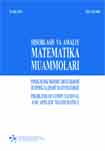Numerical Solution of Plane Problems of the Theory of Elasticity Directly in Stresses
DOI:
https://doi.org/10.71310/pcam.4_68.2025.02Keywords:
stress, Beltrami-Michell equations, equilibrium equations, difference equations, iterative method, marching methodAbstract
Usually, the solution of a plane problem of the theory of elasticity in stresses is reduced to solving a biharmonic equation for the Airy stress function. In this paper, two (A and B) variants of plane boundary value problems of the theory of elasticity are formulated directly in terms of stresses. In the first case (A), the boundary value problem consists of two equilibrium equations and one Beltrami-Michell equation with the corresponding boundary and additional boundary conditions. In the formulation of the second plane boundary value problem (B), in contrast to the first, the equations of equilibrium differentiated with respect to x and y, respectively, are used. Symmetric finite-difference equations are constructed and the known Timoshenko-Goodier problem of stretching a rectangular plate with a parabolic load is solved for comparison. The discrete analogs of boundary value problems A and B are composed by the finite-difference method and the iterative method and the marching method are used to solve them. By comparing the numerical results of boundary value problems, A and B obtained by two methods, the validity of the formulated boundary value problems and the reliability of the obtained results are ensured.
References
Novatsky V. 1975. Theory of Elasticity.– Moscow: Mir,– 872 p.
Pobedrya B.E., Sheshenin S.V., Kholmatov T. 1988. Stress-related Problems. Tashkent, Fan,– 200 p.
Pobedrya B.E. 1996. Numerical Methods in the Theory of Elasticity and Plasticity. Moscow: Moscow State University Press,– 343 p.
Timoshenko S.P., Goodier J. 1979. Theory of Elasticity. Moscow: Nauka,– 560 p.
Pobedrya B.E. 1980. A New Formulation of the Problem in the Mechanics of Deformable Solids under Stress. Reports of the USSR Academy of Sciences,– Vol. 253.– Issue 2.– P. 295–297.
Samarskiy A.A., Nikolaev E.S. Methods for solving grid equations. Moscow: «Science», 592 p.
Ike C.C., Nwoji C.U., Mama B.O., Onah H.N., Onyia M.E. 2020. Least Squares Weighted Residual Method for Finding the Elastic Stress Fields in Rectangular Plates Under Uniaxial Parabolically Distributed Edge Loads. JCAMECH– Vol. 51.– No. 1.– P. 107–121. DOI: 10.22059/jcamech. 2020.298072084.
Li S., Gupta A. and Markenscoff X. 2005. Conservation Laws of Linear Elasticity in Stress Formulations. Proceedings: Mathematical, Physical and Engineering Sciences,– Vol. 461.– No. 2053.– P. 99–116.
Filonenko-Borodich M. 2003. Theory of Elasticity. University Press of the Pacific,– 396 p.
Georgievskiy D.V. 2013. General Solutions of Non-Equivalent Classical Systems in Stress Based Elasticity Theory Moscow University Bulletin. Series 1: Mathematics, Mechanics, No. 6.– P. 26–32.
Muravleva L.V. 1987. Application of Variational Methods in Solving Spatial Problems of Stress-Based Elasticity Theory. Candidate Thesis Abstract. Moscow State University,
Khaldjigitov A.A., Djumayozov U.Z. Tilovov O.O. 2023. A new approach to numerical simulation of boundary value problems of the theory of elasticity in stresses and strains. "EUREKA: Physics and Engineering" DOI: 10.21303/2461-4262023.002735
Pobedrya B.E., Georgiyevskii D.V. 2006. Equivalence of Formulations for Problems in Elasticity Theory in Terms of Stresses. Russian Journal of Mathematical physics, DOI: 10.1134/S1061920806020063
Konovalov A.N. 1979. Solution of Problems in Stress-Based Elasticity Theory. Novosibirsk: Novosibirsk State University,– 92 p.
Pobedrya B.E., Kholmatov T. 1982. On the Existence and Uniqueness of Solutions in Stress Based Elasticity Theory Problems. Moscow University Bulletin. Series 1: Mathematics, Mechanics,– Issue I,– P. 50–51.
Borodachev N.M. 2006. Stress Solutions to the Three-Dimensional Problem of Elasticity. Intern. Appl. Mech.,– No. 42(8).– P. 849–878.
Rozhkova E.V. 2009. On Solutions of the problem in Stresses with the Use of Maxwell Stress Functions. Mechanics of Solids,– No. 44(1).– P. 526–536.
Khaldjigitov A.A., Kalandarov A.K., Yusupov Yu.S. 2019. Coupled Problems of Thermoe lasticity and Thermoplasticity. Tashkent: "Fan va texnologiya",– 193 p.
Ike C.C. 2018. On Maxwell’s Stress Functions for Solving Three Dimensional Elasticity Problems in the Theory of Elasticity. JCAMECH,– Vol. 49. 2.– P. 342–350. DOI: 10.22059/JCAMECH.2018.266787.330.
Akhmedov A., Kholmatov T. 1982. Solution of some problems on the equilibrium of a parallelepiped in stresses. Reports of the Academy of Sciences of the UzSSR,– Vol. 6.– P. 7–9.
Khaldjigitov A.A., Tilovov O.O., Djumayozov U.Z. 2023. Numerical solution of the prob lem of equilibrium of a parallelepiped in stresses. E3S Web of Conferences 401, 02019 CONMECHYDRO https://doi.org/10.1051/e3sconf/202340102019.
Khaldjigitov A., Tilovov O., Khasanova Z. A new approach to problems of thermoelasticity in stresses // Journal of Thermal Stresses, https://doi.org/10.1080/01495739.20218379803.

Downloads
Published
Issue
Section
License
Copyright (c) 2025 Khaldjigitov A.

This work is licensed under a Creative Commons Attribution 4.0 International License.



